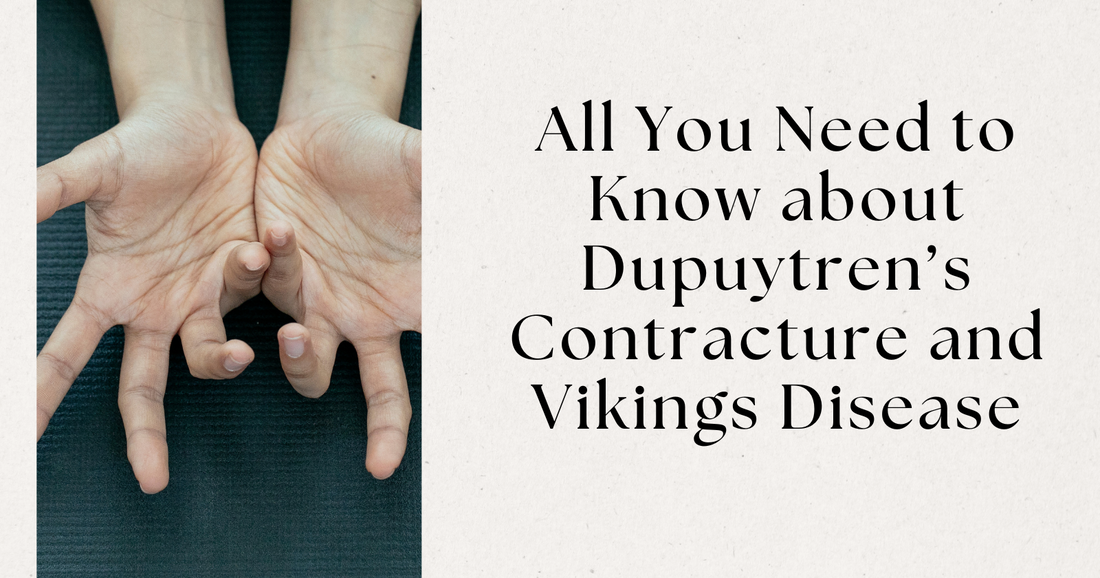Dupuytren’s Contracture or Vikings Disease is caused by an abnormal tightening and thickening of the fascia, under the skin, on the palm.
Dupuytren’s disease is normally a slow and relatively painless medical condition. Initially, soft lumps and pitted skin start to grow in the palm. Over time it gets thick, and a rope-like nodule is developed that pulls the fingers towards the palm into a bent position. These cords make it difficult to stretch the fingers or rest your hand flat on any surface. The little and ring fingers are usually affected; however, it may affect any or all the fingers, including the thumb.
Dupuytren’s disease, also known as Viking hand syndrome, is suspected to be a hereditary disorder in the family; however, the exact cause is still unknown. Numerous risk factors are believed to contribute to developing Dupuytren’s contracture or Viking disease.
These include:
Gender: Men are eight times more likely to suffer this condition than women.
Ancestry: Common in people with Northern European and Scandinavian ancestry.
Excess alcohol and tobacco use can exasperate this condition.
Diabetes can exasperate this condition.
Age: Occurrence increases with age.
What causes Dupuytren’s contracture?
As mentioned earlier, the cause of Dupuytren’s contracture is still unknown. Still, certain factors raise the risk, such as being male, over 50 years of age, and being of Northern European descent.
Why is Dupuytren’s contracture known as Viking disease?
Dupuytren’s disease has been named “the Viking hand syndrome” due to its occurrence in Northern European descent. According to history, this condition was common among the Vikings, who occupied and invaded much of Northern Europe, spreading the disease in the populations they intermarried with.
Can Dupuytren’s contracture be cured?
Mild cases are usually observed until the condition develops where medical assistance is required.
Home remedies for Dupuytren’s Disease
Though there is no specific cure for Dupuytren’s contracture. The treatment focuses on reducing the symptoms of the disease. While surgical treatment is an option — and many a time it becomes a necessity — there are a number of at-home treatments that you can try to get rid of Dupuytren’s contracture or Viking hand:
Reduce palm pressure: The skin on the palm is where the disease begins. You can manage your symptoms by safeguarding the affected hand:
Practice a loose grip: The palm bends when we hold something, forming a curl position around the object. Remember to safeguard your hands whenever you need to hold something by using looser pressure.
Wear gloves: Some objects require a tighter grip to be used effectively. Try to alleviate some pressure by wearing hand gloves or using a cushion-like Dupuytren’s Tape that helps minimize the amount of pressure on the affected hands.
Try exercises: There are a number of exercises that help manage the condition. Exercises and stretches do not necessarily stop or slow the development of the contracture but are a helpful option at the early stages of Dupuytren’s disease:
Finger lifts: One easy exercise is to lay your palm flat on a table. Next, try raising every finger one at a time and pausing at each raise for some time. Try to repeat this exercise many times a day.
Finger spreads: With your palm on the table, try to stretch your fingers by spreading them as wide as you can and slowly drawing them back together.
Seek Professional Level Treatment from the Dupuytren’s Wand
At Dupuytren’s Wand, we know the frustrating impact Dupuytren’s contracture and Vikings disease brings to your life. Our skilled team is here to offer you different options, including the Dupuytren’s Wand and Dupuytren’s Tape, and jelly. If you think it’s the right time for a professional-level treatment, reach out to us with questions today.

